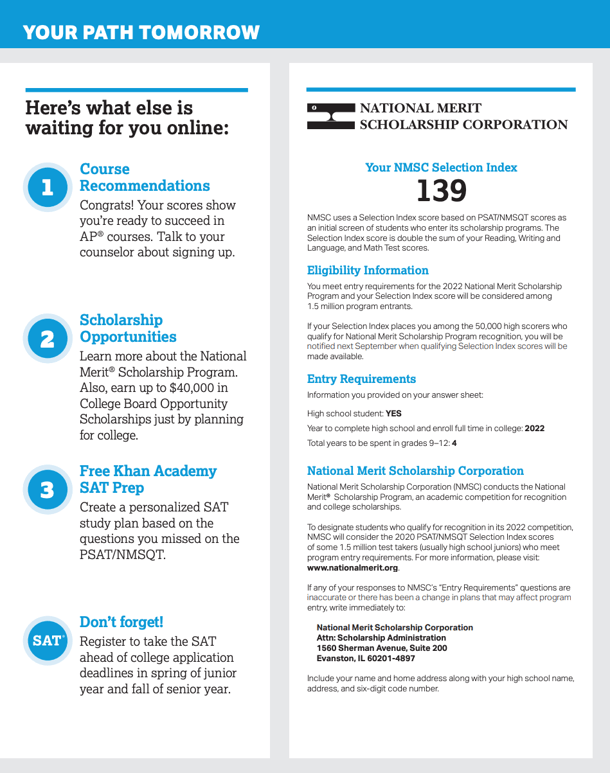It’s that time of year again. In October, students across the country sit for the PSAT, and starting in early November, they begin to receive their PSAT score reports. (Late October test-takers will likely receive their scores in early December.)
But what then? Below are the answers to all your questions.
How do I read the report?
The score report contains lots of letters and numbers. Here’s how to make sense of what you see.
Total Score: Scores range from 320 to 1520 on the PSAT.
Section Scores: These are your scores for each section of the PSAT.
- You'll receive two section scores: one for the Reading & Writing section and one for the Math section.
- Each section receives a score between 160 and 760.
- The Reading & Writing score is added to the Math score for a total score out of 1520.
- Example: 680+640 = 1320.
Percentiles: Each percentile rank represents the percentage of students whose scores are equal to or lower than yours. A total score of 1320, for example, puts you in the 98th percentile, meaning 98% of students in your grade in the US earned scores at or below yours.
NMSC Selection Index: To calculate this score, double the Reading & Writing section score, add that number to the Math score, and then divide the result by 10.
- Example: If you earn scores of 680 in Reading & Writing and 640 in math, then, your selection index is
2(680) + 640 10 =200. - If your Selection Index score is high enough and you fulfill the other requirements, you may qualify for the National Merit Scholarship Program. Every state has its own specific Selection Index score cut-off for qualifying students, and this number can change from one year to the next.
Knowledge and Skills: This part indicates how you performed in each of the eight content domains measured on the PSAT.
The Reading & Writing domains are Information & Ideas, Expression of Ideas, Craft & Structure, and Standard English Conventions. At first glance these domains may not seem very clear, so here is a deeper dive into the specific types of questions included in each domain:
- The information & Ideas domain includes questions that ask for an answer that would strengthen or weaken a claim, questions that ask for a main idea or for information that is true based on the text, and questions that ask for a phrase that will logically complete the text.
- The Expression of Ideas domain includes questions that ask for a logical transition and questions that provide test-takers with a set of bullet-point notes that a student has taken and then ask for a choice that uses the notes to best accomplish a specific goal (rhetorical synthesis questions).
- The Craft & Structure domain includes words in context questions that ask students to choose the best vocabulary word for a sentence, questions that ask about the main purpose or structure of the text or for the function of a part of the text, and questions that ask about the relationship between two different texts.
- The Standard English Conventions domain includes questions that ask about grammar and punctuation.
The Math domains are Algebra, Advanced Math, Problem Solving & Data Analysis, and Geometry & Trigonometry. Here's a bit more on the types of questions included in each domain:
- The Algebra domain includes questions that test linear equations, linear inequalities, linear functions, and systems of linear equations.
- The Advanced Math domain includes questions that test non-linear functions, non-linear equations, and systems of non-linear equations, and questions that ask for equivalent expressions.
- The Problem Solving & Data Analysis domain includes questions that ask about ratios, rates, unit conversion, percents, mean, median, mode, standard deviation, probability, and surveys and samples
- The Geometry & Trigonometry domain includes questions that test area, volume, lines, angles, triangles, circles, and right-triangle trigonometry.
What do my scores mean?
PSAT scores are meant to predict where you might score on the SAT if you were to sit for one the same day. The SAT is a bit longer and more difficult than the PSAT, which is why the highest possible PSAT score is 1520 and the highest possible SAT score is 1600: the PSAT cannot accurately predict how top scorers will perform on the most advanced questions on a longer exam.
Is my PSAT score good?
When it comes to college admissions, “good” means different things for different students. It mostly depends on the type of college you want to attend. Talk to your college counselor, and take a look at the admissions websites of colleges you plan to apply to. They often report the average SAT score of students they admit.
Another way to judge your score is to look at the percentile for each of your section scores. The higher the percentile, the better you did in comparison to other students.
Is my PSAT score important?
Yes and no. Yes, it’s important because it gives you a good idea of where you are starting from. But it has little to no effect on your college application. Except in very rare cases, colleges will not ask for your PSAT score, and you won’t report it on your college applications.
But what about scholarships? Does it matter for those?
There are a few private scholarship programs that do consider your PSAT score. The biggest is the National Merit Scholarship. The National Merit Scholarship is a $2,500 college scholarship given to the top 7,600 juniors in the United States. It may not be a lot of money given the high cost of college, but it is a very prestigious award. If you are a National Merit semifinalist, finalist, or winner, you can list it on your college application to make yourself more attractive to colleges.
Taking the PSAT is the first step in the National Merit Scholarship competition. In fact, just by taking the exam you entered the competition (whether or not you realized it). Only the highest scorers in your state will move on and qualify as semifinalists in the competition. This usually requires a Selection Index in the 96th percentile or higher. That means that only the top 4% of scorers need to worry about the National Merit competition. If you are selected as a semifinalist, your college guidance counselor will notify you in April.
Keep in mind, National Merit only applies for US citizens in their junior year. If you took the exam as a sophomore or freshman, or if you are not a US citizen, you won’t be considered for National Merit.
What do I do next?
This is the most important question you should be asking. The PSAT’s only real value is helping you decide how to prepare for college admissions.
1) Log into your College Board account. This account will give you access to your score report, which will show you how you performed in each of the eight domains tested on the exam.
2) Look at the domains in which you struggled most. Unfortunately, you won't be able to see a list of the exact questions that you missed or answered correctly on the PSAT. However, you will get a rough breakdown of how you performed in each domain. Identify and create a list of the ones that are giving you the most trouble.
3) Plan your prep. Now that you know where you are starting, take a look at some of the colleges you are interested in and figure out how close you are to their average SAT scores. Knowing where you stand can tell you how much time you might need to set aside for test prep. Begin to plan your timeline now.
To help you better understand your PSAT score and further prepare for college admissions, ArborBridge offers free practice SATs with customized score reports. Taking a practice SAT is an ideal way to gauge your performance before the official exam, and it's also an effective method of analyzing where you stand on the PSAT. Click here to learn more.
The PSAT is only the first step in the long college admissions road. But it’s an important one that lays the groundwork for much of lies ahead. Being proactive now is the key to success!
Need more individualized advice?
The recommendations above are general suggestions. If you have specific questions, reach out to our experts here. We’re happy to help in any way we can.









